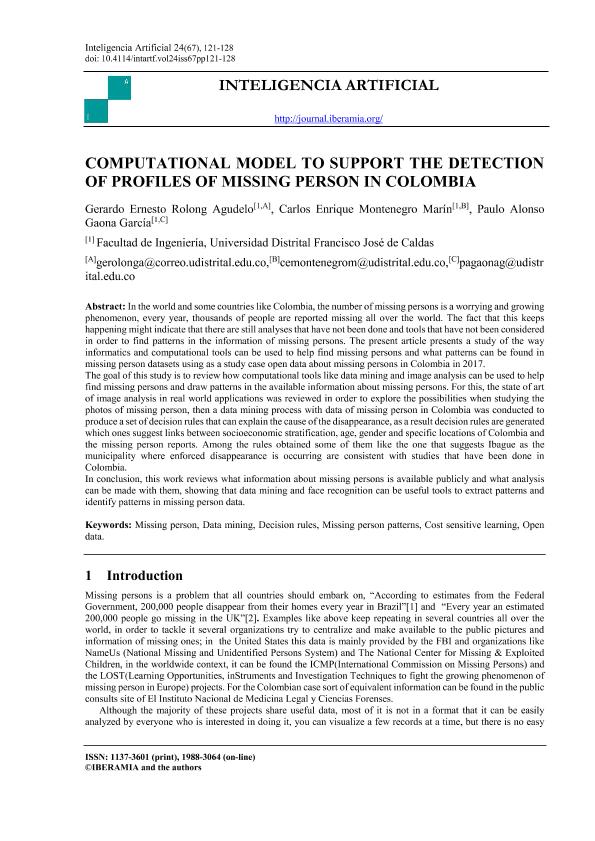Computational model to support the detection of profiles of missing person in Colombia

Contenido multimedia no disponible por derechos de autor o por acceso restringido. Contacte con la institución para más información.
| Tag | 1 | 2 | Valor |
|---|---|---|---|
| LDR | 00000cab a2200000 4500 | ||
| 001 | MAP20210024566 | ||
| 003 | MAP | ||
| 005 | 20220911185852.0 | ||
| 008 | 210727e2021 esp|||p |0|||b|spa d | ||
| 040 | $aMAP$bspa$dMAP | ||
| 084 | $a922.134 | ||
| 100 | $0MAPA20210030260$aRolong Agudelo, Gerardo Ernesto | ||
| 245 | 1 | 0 | $aComputational model to support the detection of profiles of missing person in Colombia$c Gerardo Ernesto Rolong Agudelo, Carlos Enrique Montenegro Marín, Paulo Alonso Gaona García |
| 520 | $aIn the world and some countries like Colombia, the number of missing persons is a worrying and growing phenomenon, every year, thousands of people are reported missing all over the world. The fact that this keeps happening might indicate that there are still analyses that have not been done and tools that have not been considered in order to find patterns in the information of missing persons. The present article presents a study of the way informatics and computational tools can be used to help find missing persons and what patterns can be found in missing person datasets using as a study case open data about missing persons in Colombia in 2017. The goal of this study is to review how computational tools like data mining and image analysis can be used to help find missing persons and draw patterns in the available information about missing persons. For this, the state of art of image analysis in real world applications was reviewed in order to explore the possibilities when studying the photos of missing person, then a data mining process with data of missing person in Colombia was conducted to produce a set of decision rules that can explain the cause of the disappearance, as a result decision rules are generated which ones suggest links between socioeconomic stratification, age, gender and specific locations of Colombia and the missing person reports. Among the rules obtained some of them like the one that suggests Ibague as the municipality where enforced disappearance is occurring are consistent with studies that have been done in Colombia. In conclusion, this work reviews what information about missing persons is available publicly and what analysis can be made with them, showing that data mining and face recognition can be useful tools to extract patterns and identify patterns in missing person data. | ||
| 650 | 4 | $0MAPA20080546717$aCrímenes | |
| 650 | 4 | $0MAPA20210010484$aDatos abiertos | |
| 650 | 4 | $0MAPA20080611200$aInteligencia artificial | |
| 651 | 1 | $0MAPA20080638030$aColombia | |
| 700 | 1 | $0MAPA20210030284$aMontenegro Marín, Carlos Enrique | |
| 700 | 1 | $0MAPA20210030291$aGaona García, Paulo Alonso | |
| 773 | 0 | $wMAP20200034445$tRevista Iberoamericana de Inteligencia Artificial$dIBERAMIA, Sociedad Iberoamericana de Inteligencia Artificial , 2018-$x1988-3064$g15/02/2021 Volumen 24 Número 67 - febrero 2021 , p. 121-128 |

